Where Do Spades, Hearts, Diamonds and Clubs On Playing Cards Come From?
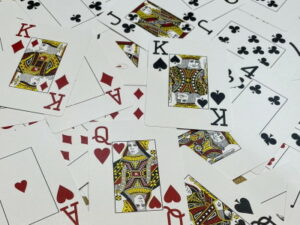 Anyone who has ever played card games will know what a deck of them looks like. Whether in blackjack, poker, solitaire, baccarat. Whatever the case, players utilise decks of cards to play the games. Of course, each different card game has different rules in place. Some games don’t utilise all the cards, while others sometimes use several decks.
Anyone who has ever played card games will know what a deck of them looks like. Whether in blackjack, poker, solitaire, baccarat. Whatever the case, players utilise decks of cards to play the games. Of course, each different card game has different rules in place. Some games don’t utilise all the cards, while others sometimes use several decks.
Yet, what remains the same is the designs on those cards. They all run from the ace up through two, three, four and so on, finishing with J, Q, K. What is even more obvious about the playing cards is their suits. Everyone knows that they feature hearts, clubs, diamonds and spades. Each suit applies itself to a series of cards from ace through to king.
The question is where do these suits come from? Why do we use hearts, diamonds, clubs and spades on them? What are their origins? The likelihood isn’t that someone thought of them as random additions to the cards. We want to delve into the background behind using these iconic playing card images. When did they first appear on the cards, too? We’re going to take a closer look at the suits and their designs.
Going Back in Time
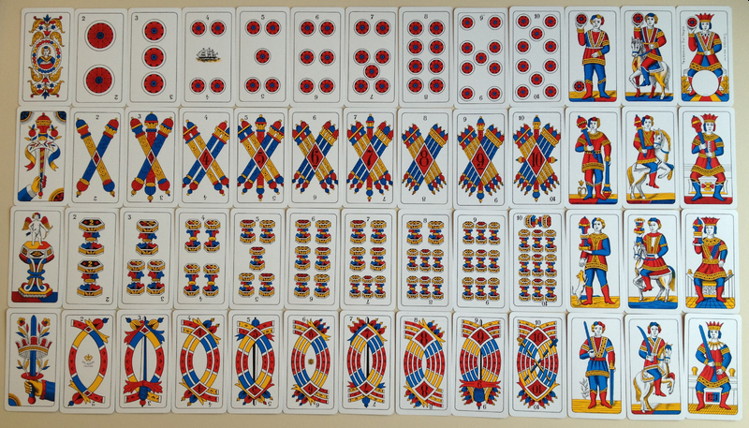
Italian playing card designs from the 14th or 15th century – Countakeshi, CC BY-SA 4.0, via Wikimedia Commons
It may surprise you but playing cards haven’t always featured the suits we see today. Modern Western playing cards are usually divided up into two or three general sets. The older Latin ones are also sub-divided into Italian and Spanish suit-systems. Then, the younger Germanic suits are also sub-divided into German and Swiss suit-systems. French suits come as a derivative of the German suits. Yet it is common to consider them as a separate system.
Of all those, it is the French suit system that today’s hearts, spades, clubs and diamonds come from. The German system has also utilised hearts and leaves (which look like spades) within.
French-suited playing cards use the following symbols on them:
- Trèfles (clovers/clubs)
- Carreaux (tiles/diamonds)
- Cœurs (hearts)
- Piques (pikes/spades)
French cards of this nature are the most widespread. This is because of the geopolitical, commercial and cultural influence of France. Yet also due to the fact that the United Kingdom and USA adopted them over all others. Within the 19th and 20th centuries, people held these countries in high regard. Thus, their influence helped the cards to gain much more popularity. At the same time, the simplicity of the card suits helped with mass production. So, it was a lot easier to print these cards than say the Swiss-German or Latin designs.
Playing cards actually came to Europe from Mamluk Egypt in around 1370. Early reports from France suggest they were present and active there in 1377. The French suits derived from German suits in around 1480, though. Yet we’ll need to go back a bit further than these years to the Latin suits.
The earliest card games to ever come into existence were trick-taking games. The creation of suits increased the level of strategy and depth within them. Suits go back even further than card games, though – back to ancient Chinese dice and domino games. Chinese money-suited cards came from those games, being ancestors to the Latin system. They featured suits of currency at the time.
The Islamic world spread into China and also adopted those playing cards. Yet they changed certain aspects of the cards. Turko-Arabic cards soon came about, using the coins, clubs, cups and swords suits. They were used to play a game known as Ganjifa. The clubs within that set represented polo sticks.
Europeans adjusted that suit, because polo was an obscure sport on the continent. This made the Latin suit of coins, clubs, cups and swords as the earliest ones in use in Europe. Four types of Latin suits exist – Italian, Spanish, Portuguese and an extinct archaic set. The four systems are distinguishable by the pips of the long suits – swords and clubs. This plays out as follows:
- Northern Italian swords are curved outward while clubs seem to be batons. These intersect one another.
- Southern Italian and Spanish swords are straight, while clubs appear to be cudgels. They do not cross each other, except for on the three of clubs).
- Portuguese pips are the same as the Spanish ones, but they intersect like the Northern Italian ones. Sometimes dragons appear on the aces.
- The archaic system is like the Northern Italian one, but the swords curve inward, touching each other without intersecting.
The Introduction of German and French Suits
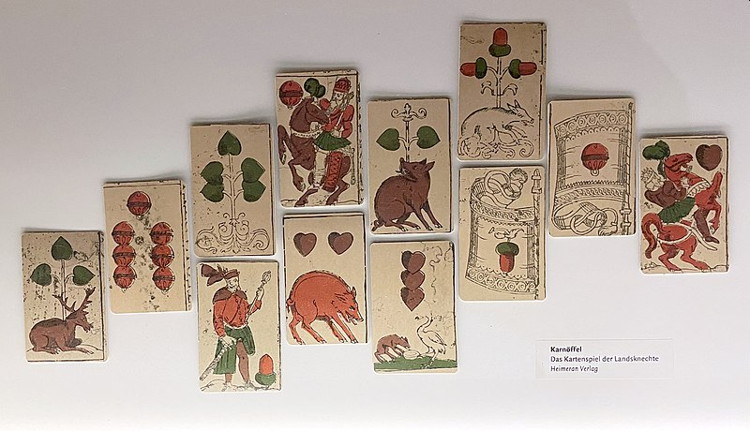
15th century German playing cards – Unknown authorUnknown author, Public domain, via Wikimedia Commons
During the 15th century, German manufacturers began toying with new suit designs. These were to replace the Latin systems. One of the early decks had five suits included, with the extra one featuring shields. In 1450, Swiss-Germans developed their own suits of shields, roses, acorns and bells. Rather than using roses and shields, the Germans were for hearts and leaves around 10 years later. Then, 20 years after that, the French derived their suits from the German ones.
The Paris pattern is what came to dominate in France in around 1780. This began going by the name of portrait officiel. The French government regulated the appearance of the cards used within until 1945. Prints of the cards occurred on watermarked paper made by the state. This showed payment of the stamp tax there, too.
The most common deck sold in France is the 32-card deck. In this, the 2 through 6 cards are not present. Yet 52-card decks are also popular. Further to this, the French have a habit of associating face cards with people from history. They aren’t always factual people either, as you will see below:
- King of Spades – David, the third king of the United Kingdom of Israel.
- King of Hearts – Charles, King of the Franks from 768, King of the Lombards from 774, and first Emperor of the Romans from 800.
- King of Diamonds – Caesar, Roman general and statesman, dictator from 49 BC.
- King of Clubs – Alexander the Great, King of the kingdom of Macedon.
- Queen of Spades – Athena, ancient Greek goddess associated with wisdom, warfare and handicraft.
- Queen of Hearts – Judith, the Jewish widow in the Bible’s book of Deuteronomy.
- Queen of Diamonds – Rachel, the favourite of Jacob’s two wives in the Bible.
- Queen of Clubs – Argine, an anagram of Regina, Latin for “queen”.
- Jack of Spades – Ogier the Dane, a legendary paladin of Charlemagne.
- Jack of Hearts – La Hire, a French military commander during the Hundred Years’ War.
- Jack of Diamonds – Hector, a Trojan prince in Greek mythology, and the greatest warrior for Troy during the Trojan war.
- Jack of Clubs – Lancelot du Lac, a character of Arthurian legend, typically depicted as King Arthur’s close companion.
A Belgian-Genoese pattern also came about from the Parisian pattern. Yet this version was not subject to France’s domestic stamp tax. Because of this, they lack the usual French court card names mentioned above. Other differences include the Jack of Clubs, which has a triangular shield. On that shield is the coat of arms of the former Spanish Netherlands. Blue is also usually replaced with green in the portraits.
When the Ottoman Empire relaxed its ban against playing cards, this Belgian system entered the scene. They are now found throughout the Balkans, North Africa and Middle East. France’s former colonies also adopted this set of cards.
The English names for the French suits of clubs and spades could have come from the Latin suits. Thus, the English names have a sort of merger of Latin names and French names.
There is also a Piedmontese pattern, which has similarities to the Genoese packs. The face cards have a horizontal rather than a diagonal dividing line. Meanwhile, the aces tend to come with a decorative garland. This system was once used in neighbouring Savoy, because they were in a unison at one point. France annexed the latter in 1860, though.
Other Derivatives and Patterns from the French System
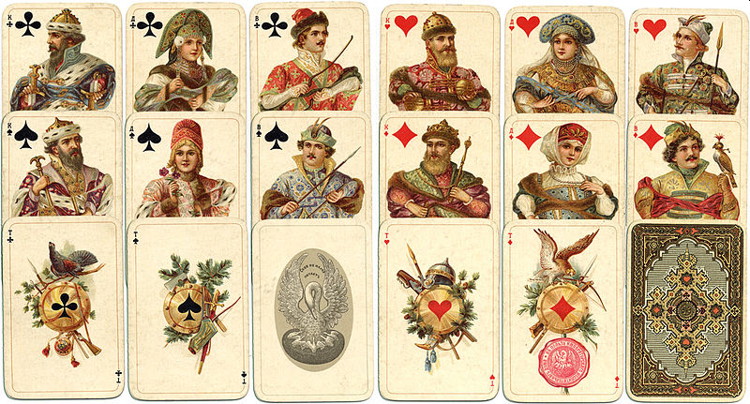
Russian playing card deck from 1911 – “Dondorf GmbH” (Germany), Public domain, via Wikimedia Commons
As well as the English version of playing cards coming from the French system, there are some others. A Parisian variant appeared in Bavaria in the mid-18th century, for example. The kind of diamonds had a turban on in this version. This one originates from the German-suited Old Bavarian pattern. The king of Spades, represented by David, no longer has a harp in this set.
Strange as it may seem, there is also a Russian pattern deriving from the French one. Created in the early 19th century, it bases itself on the Baltic version of a Bavarian derivative. Adolf Charlemagne finalised the current appearance. He was a Russian painter of historical, genre and battle scenes. His design became known as the “Satin Deck”. It usually features 52 or 36 cards. The latter deck comes into play in the game Durak and is popular in many post-Soviet states.
Throughout Germany, there are also several different decks coming from the French design. These are:
- Adler Cego – Used in the Black Forest to play Cego, and serves as the last remaining animal tarot.
- Industrie und Glück – Translating to “Diligence and Fortune”, this tarock deck is from Central Europe. It utilises Roman numerals for trumps and is organised like the Adler Cego set.
- Hamburg Pattern – The city of Hamburg was once a major card-producing hub. Makers there began revising the Paris pattern to create the Hamburg one. The King of Spades holds David’s harp and also has a sceptre in the other hand.
- North German Pattern – Created in Stralsund from a Hamburg derivative. More commonly known as the Berlin pattern. Queens in the set are all crownless and reflect the hairstyles of the Biedermeier period.
- French-Swiss Pattern – Similar to the North German pattern but without corner indices and Arabic numerals found within the pips closest to the corner.
- Modern Portuguese Pattern – Also a Parisian derivative from Germany. Upon arriving in Portugal, the kings and jacks in the hearts and diamonds swapped suits.
- Dutch Pattern – Originates from Germany and shares the same parent as the Modern Portuguese pattern but with different queens. Scenic aces are also included.
- Dondorf Rhineland Pattern – Produced in 1870, the kings come with very thick beards. Fallen out of popularity in Germany, but very popular in Poland, Austria, the Netherlands, Denmark and the Baltic States.
The Current English Pattern
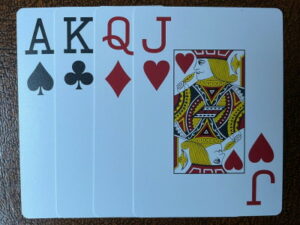 Card makers based in Rouen started to export cards to England in around 1480. Yet before this time, Latin-suited cards were likely circulating in England. Evidence suggests that playing cards were in the country in around 1450. French suits weren’t invented until after 1470. An explanation was there about why the English renamed French suits to Latin ones. They were much more familiar to people in England. The clovers became clubs, and the pikes became spades, named after swords. It was over a century later until the English began producing their own cards.
Card makers based in Rouen started to export cards to England in around 1480. Yet before this time, Latin-suited cards were likely circulating in England. Evidence suggests that playing cards were in the country in around 1450. French suits weren’t invented until after 1470. An explanation was there about why the English renamed French suits to Latin ones. They were much more familiar to people in England. The clovers became clubs, and the pikes became spades, named after swords. It was over a century later until the English began producing their own cards.
This led to the country banning the importation of foreign cards in 1628. Local manufacturers were therefore protected. Yet the English cards were of a lower quality than those produced in mainland Europe. It was due to this that were was a loss of detail in the Rouennais pattern. A reworking of that pattern in the 19th century by Charles Goodall and Son’s restored it.
There are also other card patterns utilising the original French design. They include the Vienna pattern, which takes its cues from the Lyonnais pattern. It survived in Austria and the Czech Republic, while dying out in other countries. The Lombard pattern is another one, which operates as a 40-card deck, omitting the 8s, 9s and 10s. Then there is the Tuscan pattern, dating from the mid-19th century.
Finally, there is the Baronesse pattern available. Dondorf of Frankfurt produced is in around 1900. It is often used for playing Patience. Court cards appear dressed in rococo period costumes and wear powdered wigs. Kings have crowns and carry state regalia. Queens are also crowned and sport jewellery. Meanwhile, Jacks are young gentlemen wearing tricorn hats.



